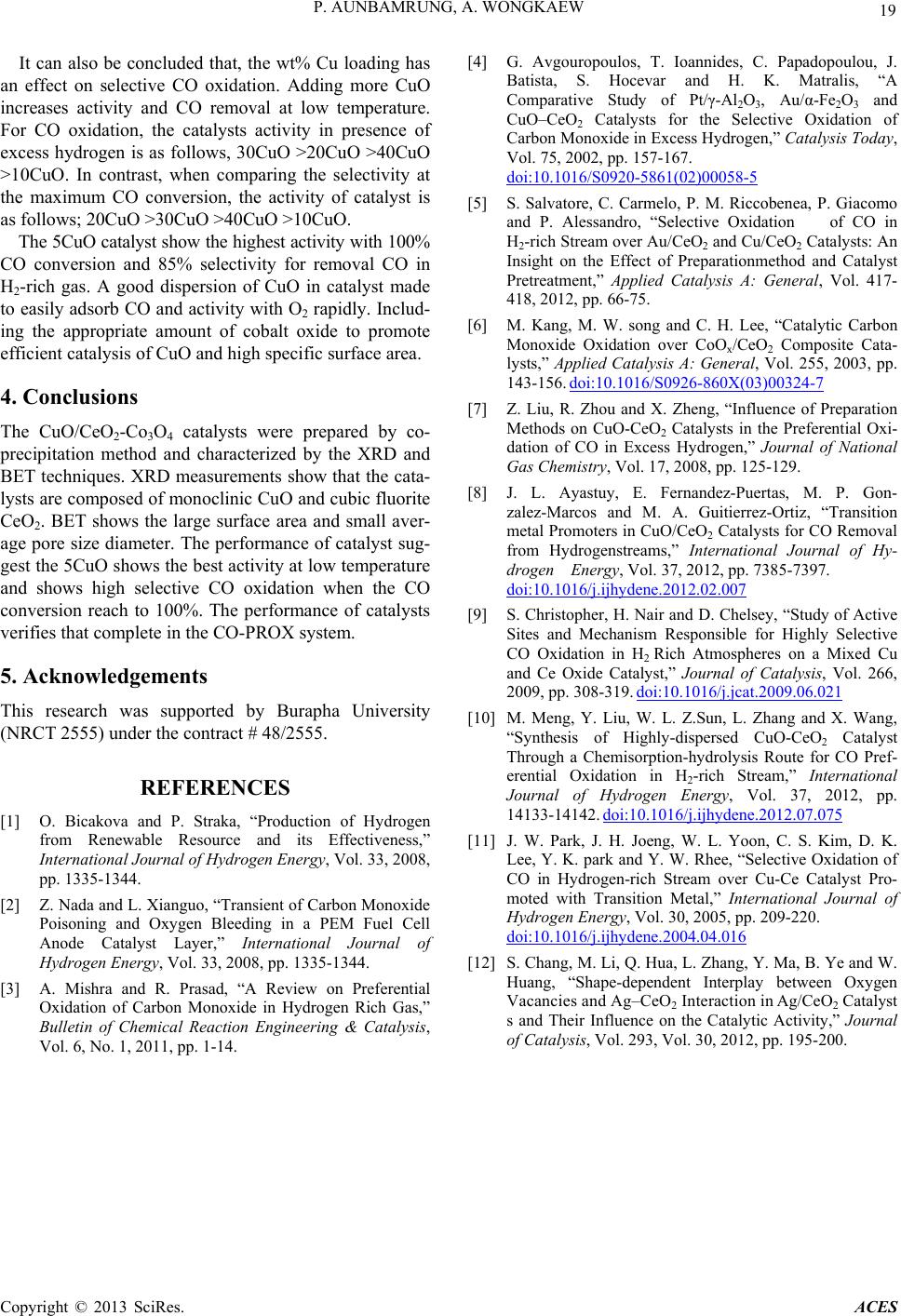
P. AUNBAMRUNG, A. WONGKAEW 19
It can also be concluded that, the wt% Cu loading has
an effect on selective CO oxidation. Adding more CuO
increases activity and CO removal at low temperature.
For CO oxidation, the catalysts activity in presence of
excess hydrogen is as follows, 30CuO >20CuO >40CuO
>10CuO. In contrast, when comparing the selectivity at
the maximum CO conversion, the activity of catalyst is
as follows; 20CuO >30CuO >40CuO >10CuO.
The 5CuO catalyst show the highest activity with 100%
CO conversion and 85% selectivity for removal CO in
H2-rich gas. A good dispersion of CuO in catalyst made
to easily adsorb CO and activity with O2 rapidly. Includ-
ing the appropriate amount of cobalt oxide to promote
efficient catalysis of CuO and high specific surface area.
4. Conclusions
The CuO/CeO2-Co3O4 catalysts were prepared by co-
precipitation method and characterized by the XRD and
BET techniques. XRD measurements show that the cata-
lysts are composed of monoclinic CuO and cubic fluorite
CeO2. BET shows the large surface area and small aver-
age pore size diameter. The performance of catalyst sug-
gest the 5CuO shows the best activity at low temperature
and shows high selective CO oxidation when the CO
conversion reach to 100%. The performance of catalysts
verifies that complete in the CO-PROX system.
5. Acknowledgements
This research was supported by Burapha University
(NRCT 2555) under the contract # 48/2555.
REFERENCES
[1] O. Bicakova and P. Straka, “Production of Hydrogen
from Renewable Resource and its Effectiveness,”
International Journal of Hydrogen Energy, Vol. 33, 2008,
pp. 1335-1344.
[2] Z. Nada and L. Xianguo, “Transient of Carbon Monoxide
Poisoning and Oxygen Bleeding in a PEM Fuel Cell
Anode Catalyst Layer,” International Journal of
Hydrogen Energy, Vol. 33, 2008, pp. 1335-1344.
[3] A. Mishra and R. Prasad, “A Review on Preferential
Oxidation of Carbon Monoxide in Hydrogen Rich Gas,”
Bulletin of Chemical Reaction Engineering & Catalysis,
Vol. 6, No. 1, 2011, pp. 1-14.
[4] G. Avgouropoulos, T. Ioannides, C. Papadopoulou, J.
Batista, S. Hocevar and H. K. Matralis, “A
Comparative Study of Pt/γ-Al2O3, Au/α-Fe2O3 and
CuO–CeO2 Catalysts for the Selective Oxidation of
Carbon Monoxide in Excess Hydrogen,” Catalysis Today,
Vol. 75, 2002, pp. 157-167.
doi:10.1016/S0920-5861(02)00058-5
[5] S. Salvatore, C. Carmelo, P. M. Riccobenea, P. Giacomo
and P. Alessandro, “Selective Oxidation of CO in
H2-rich Stream over Au/CeO2 and Cu/CeO2 Catalysts: An
Insight on the Effect of Preparationmethod and Catalyst
Pretreatment,” Applied Catalysis A: General, Vol. 417-
418, 2012, pp. 66-75.
[6] M. Kang, M. W. song and C. H. Lee, “Catalytic Carbon
Monoxide Oxidation over CoOx/CeO2 Composite Cata-
lysts,” Applied Catalysis A: General, Vol. 255, 2003, pp.
143-156. doi:10.1016/S0926-860X(03)00324-7
[7] Z. Liu, R. Zhou and X. Zheng, “Influence of Preparation
Methods on CuO-CeO2 Catalysts in the Preferential Oxi-
dation of CO in Excess Hydrogen,” Journal of National
Gas Chemistry, Vol. 17, 2008, pp. 125-129.
[8] J. L. Ayastuy, E. Fernandez-Puertas, M. P. Gon-
zalez-Marcos and M. A. Guitierrez-Ortiz, “Transition
metal Promoters in CuO/CeO2 Catalysts for CO Removal
from Hydrogenstreams,” International Journal of Hy-
drogen Energy, Vol. 37, 2012, pp. 7385-7397.
doi:10.1016/j.ijhydene.2012.02.007
[9] S. Christopher, H. Nair and D. Chelsey, “Study of Active
Sites and Mechanism Responsible for Highly Selective
CO Oxidation in H2 Rich Atmospheres on a Mixed Cu
and Ce Oxide Catalyst,” Journal of Catalysis, Vol. 266,
2009, pp. 308-319. doi:10.1016/j.jcat.2009.06.021
[10] M. Meng, Y. Liu, W. L. Z.Sun, L. Zhang and X. Wang,
“Synthesis of Highly-dispersed CuO-CeO2 Catalyst
Through a Chemisorption-hydrolysis Route for CO Pref-
erential Oxidation in H2-rich Stream,” International
Journal of Hydrogen Energy, Vol. 37, 2012, pp.
14133-14142. doi:10.1016/j.ijhydene.2012.07.075
[11] J. W. Park, J. H. Joeng, W. L. Yoon, C. S. Kim, D. K.
Lee, Y. K. park and Y. W. Rhee, “Selective Oxidation of
CO in Hydrogen-rich Stream over Cu-Ce Catalyst Pro-
moted with Transition Metal,” International Journal of
Hydrogen Energy, Vol. 30, 2005, pp. 209-220.
doi:10.1016/j.ijhydene.2004.04.016
[12] S. Chang, M. Li, Q. Hua, L. Zhang, Y. Ma, B. Ye and W.
Huang, “Shape-dependent Interplay between Oxygen
Vacancies and Ag–CeO2 Interaction inAg/CeO2 Catalyst
s and Their Influence on the Catalytic Activity,” Journal
of Catalysis, Vol. 293, Vol. 30, 2012, pp. 195-200.
Copyright © 2013 SciRes. ACES